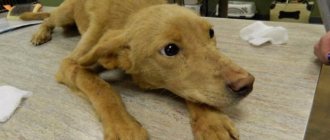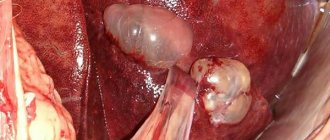- For whom is an animal infected with enteritis dangerous?
- Impact of enteritis virus on dogs
- Symptoms of enteritis in cats
- Features of enteritis in geese
The pathology, which is infectious in nature, is very contagious.
The virus that provokes its development adapts perfectly to the external environment, survives in frost and heat, and is not affected by ether, alcohol, or formaldehyde. The pathogen enters the digestive tract upon contact with a sick animal. Viral enteritis is transmitted through bedding and brush; a pet can pick it up by running on the grass, playing in the sand or a puddle. The non-infectious form of the disease occurs due to a sharp change in diet, when consuming:
- poor quality feed;
- spoiled products,
- food contaminated with fungi;
- dirty water.
Enteritis in a pet occurs due to poor care, after surgery, or in the presence of worms in the body. The impetus for the development of pathology is sometimes a new owner, a predisposition that is inherited.
Features of the disease
The development of pathology in four-legged animals occurs due to the attack of viruses, and in rare cases, bacteria. The greatest danger is the parvovirus form of enteritis.
The parvovirus pathogen, penetrating the pet’s body, quickly develops and spreads throughout the body. The mucous walls of the intestines begin to collapse, become covered with erosions, and die in a short time. In advanced cases, the infection penetrates the heart muscle, adversely affecting myocardial tissue. At the same time, parvovirus destroys the walls of blood vessels and changes the chemical composition of the blood.
All destruction occurs rapidly. By the time the first signs of the disease appear, some organs have time to suffer. Severe intoxication with decay products can lead to death at the very beginning of the development of viral enteritis in dogs.
Coronavirus and rotavirus have a weaker effect on the four-legged body. They do not penetrate the heart and do not destroy blood vessels. However, the lack of proper therapy leads to death - due to dehydration, exhaustion, and irreversible changes in the gastrointestinal tract.
Difference from plague
It is difficult for an inexperienced breeder to distinguish enteritis and the viruses that cause it from another terrible disease - distemper. The smartest thing to do is to take a sick dog to the veterinarian as soon as possible, because both distemper and other viruses require urgent and thorough treatment.
How is enteritis different from plague?
- the nervous system does not suffer, which means that convulsions and paresis are reduced to almost zero;
- there is no purulent discharge from the eyes and nose;
- the temperature can fall and rise to very high levels, whereas with plague, hyperthermia is more stable and not so significant.
As with plague, enteric diarrhea and vomiting cause dangerous dehydration, leading to exhaustion and death of the patient. The pet becomes lethargic, apathetic, and tries to hide. Trying to give him something to drink or feed does not lead to positive results.
Methods of infection
The viral microorganism is viable for a long period of time outside the host. Therefore, any secretions of an infected animal, such as feces, urine, saliva, are considered an open source of disease for a healthy individual.
A four-legged friend can become infected while sniffing or licking an object that was previously touched by a sick individual. The virus can live in different places: on the grass, in a puddle, on a stick that the owner took to throw to his pet.
A high risk of infection occurs through direct contact between relatives - it is enough to sniff an infected dog for the virus to be transmitted from an old carrier to a new carrier. Moreover, a person can bring a viral cell home on the sole of a shoe, outer clothing, or hands.
The incubation period lasts 2-10 days. Reproducing viruses are extremely resistant to disinfectants and changes in temperature conditions, and persist in living quarters for up to six months.
Is the disease enteritis transmitted from animals to humans?
The pathology, which is infectious in nature, is very contagious.
The virus that provokes its development adapts perfectly to the external environment, survives in frost and heat, and is not affected by ether, alcohol, or formaldehyde. The pathogen enters the digestive tract upon contact with a sick animal. Viral enteritis is transmitted through bedding and brush; a pet can pick it up by running on the grass, playing in the sand or a puddle. The non-infectious form of the disease occurs due to a sharp change in diet, when consuming:
- poor quality feed;
- spoiled products,
- food contaminated with fungi;
- dirty water.
Enteritis in a pet occurs due to poor care, after surgery, or in the presence of worms in the body. The impetus for the development of pathology is sometimes a new owner, a predisposition that is inherited.
Causes of the disease
Any dog of any breed is at risk of contracting the virus, even if it has all its vaccinations and is kept in ideal conditions. But still there are certain points that require increased attention from the owner.
Risk group
The risk group primarily includes unvaccinated animals: their body’s resistance is significantly lower than that of vaccinated individuals. Vaccinated pets can also become infected, but it will be mild and will not be life-threatening.
Puppies and teenagers under one year of age are also often attacked by viruses: harmful microorganisms happily settle in fragile tissues. Dogs in kennels, shelters and other crowded places are especially susceptible to enteritis.
Conditions of detention
There are several different reasons why a pet is at risk of becoming a victim of the virus:
- Lack of regular comprehensive vaccinations
. Vaccinations are given to puppies at the age of 2 months, during the first visit to the veterinary clinic. Revaccination is needed after a few weeks, and then annually.
- Poor nutrition
. The non-viral form of the pathology is often caused by poor-quality food, a sudden change in food, or food poisoning. The intestinal mucosa reacts poorly to foods that are too cold or hot. The presence of preservatives, seasonings, and an abundance of salt also causes problems.
- Weakened immunity
. A strong immune system prevents dangerous microorganisms from multiplying inside the pet's body. Weak immunity, especially in young individuals, is favorable for the development of pathogens.
- Worms
. Parasites that live inside the body cause many problems: they undermine the immune system, cause dysfunction of the gastrointestinal tract, and provoke inflammatory processes on the mucous membranes.
It is important for the owner to avoid the listed factors so that his four-legged friend can maintain good health and avoid infection. A strong immune system, proper diet and timely vaccinations form a reliable barrier against any infections.
Diagnosis of intestinal inflammation
A gastroenterologist can make a primary diagnosis based on a survey of the patient and his medical history.
A general examination and palpation of the abdominal wall should be performed.
You can reliably understand whether enteritis is viral or parasitic after laboratory testing.
A coprogram, absorption tests, and jejunoperfusion technique are performed.
Complete recovery is possible only after eliminating the causes that caused the inflammation syndrome.
Pathology is often accompanied by dysbacteriosis. When diagnosing the disease, a bacteriological examination of stool is performed, aimed at identifying concomitant infections and dysbacteriosis.
It is especially important to perform this test if symptoms include diarrhea and bloating.
Endoscopic examination is difficult with enteritis; this is inflammation of the small intestine, which is difficult to access with an endoscope. This method is used to examine the terminal sections.
At the same time, a biopsy of the mucous membrane is taken for subsequent histological examination.
Using an endoscope, you can see trophic changes in adjacent areas where viral enteritis is present.
X-ray examination is carried out against the background of the introduction of a contrast agent.
Such a study makes it possible to evaluate the motor functions of the intestine, detect segmental lesions, ulcers, atrophy of the folded structure, and neoplasms.
Forms of enteritis in dogs
Depending on the cause of intestinal inflammation, several forms of the disease are distinguished. The parvovirus form is considered the most dangerous, and the safest is non-viral enteritis.
Not viral
The symptoms of non-viral enteritis in dogs are the same as those of viral forms, but they are caused by other factors: poisoning, intestinal trauma, poor nutrition, etc. Bacterial enteritis in dogs also occurs - it is caused by attacks not viral, but other pathogenic microorganisms. To treat this form, a smaller range of medications is used, but the dog still runs the risk of dying without medical help.
Parvovirus
The most dangerous type of disease, as it has a high mortality rate - up to 85%. This is explained by the fact that the virus destroys the intestines with lightning speed and can spread to the heart. The cardiac variety has a blurred clinical picture and is most often found in small puppies that have not yet been weaned from their mother.
Coronavirus
Coronavirus enteritis in dogs is less dangerous, but also has a pitfall - it can develop in an unnoticeable form. The maximum that the owner will see is semi-liquid stool and a temporary refusal to eat. Most likely, the undetected disease will return, but in an acute form - then you need to take the necessary measures.
Adults rarely die from coronavirus, but the mortality rate in puppies is quite high. This is due to fragile immunity.
Rotavirus
Like coronavirus, rotavirus is not as dangerous for adult dogs. It is easy to notice and just as easy to confuse with banal poisoning: loose stools alternate with vomiting, the pet is lethargic and does not eat anything.
Gastroenteritis
This form involves viral enteritis, affecting not only the intestines, but also the stomach. In this case, severe vomiting, bloody diarrhea, and frequent and difficult breathing appear. Gastroenteritis causes severe exhaustion and dehydration, so the infected person will need IVs.
Impact of enteritis virus on dogs
The disease, which often affects puppies rather than adults, originated in the United States at the end of the last century. A few years later, it spread to other states and often ended in the death of the animal, because they did not have immunity to this pathology.
How enteritis manifests itself in dogs depends on its type. In the intestinal form, the following is observed:
- indifference to food;
- vomiting with yellow foam;
- diarrhea with a disgusting smell.
An active puppy suddenly lies down and does not get up, whines, arches his back from abdominal pain. After a couple of days, the body becomes dehydrated. Without treatment he cannot be saved.
The cardiac type of enteritis often leads to the death of dogs that are only a few weeks or a month old; myocarditis develops, followed by failure. In the mixed form, the intestinal mucosa is affected, the stomach is affected, and the heart muscle suffers. Treatment of parvovirus enteritis in dogs does not always give a positive result.
The first sign of pathology in any form can be lethargy of the pet, sometimes the temperature increases significantly. Even modern drugs and vaccines do not always help. Pet owners often wonder whether they can get enteritis from a dog. So far, such cases are unknown.
Symptoms of enteritis in cats
The virus, which persists in the environment for a long time, does not die when treated with antiseptics, and does not spare kittens whose owners have not been vaccinated. In adult animals, enteritis occurs:
- due to poor living conditions;
- the presence of low-quality food in the diet;
- the presence of chronic pathologies.
If you do not contact a veterinarian in time, it will take a long time to treat the disease.
Symptoms of enteritis in cats, whose body is protected by immunity, are often not noticed by owners. Small and weak pets can die within a few hours after the virus enters the intestines. Even if the pet survives, harmful microorganisms will be released with excrement, which, when they fall on the ground, grass, water, or food, will only infect other cats.
The development of enteritis in these animals is provoked by various viruses. The signs of each type of pathology are similar. The kitten becomes lethargic, does not play, does not look at the food, does not drink, and is indifferent to the owner. The pathology begins with severe vomiting and incessant diarrhea, acquiring bright colors.
If enteritis is caused by rotavirus, your pet:
- constantly meows and screams:
- bends over from acute colic;
- doesn't let you get close to him.
The temperature rises sharply, fever occurs, and streaks of blood appear in the diarrhea. The animal dies due to dehydration. You can save him if you start treatment without delay.
With parvovirus disease or feline distemper, in addition to vomiting and diarrhea, the mucous membranes swell, a cough begins, and the pet trembles and twitches. If peritonitis occurs, the animal dies.
Frightened by the death of their pet, owners often ask whether a person can become infected with enteritis while caring for a kitten. Experts believe that the pathology is transmitted only to relatives; it is not dangerous for dogs either.
Features of enteritis in geese
Parvovirus causes severe illness in poultry, which causes the death of young animals that hatched from an egg a few days ago. Derzhi disease or enteritis in geese, which affects the digestive tract, is transmitted through grain, dirty water, feed, and through contact with an infected or dead bird.
The virus attaches to the intestinal lining, from where it begins to move through the body through the bloodstream. Sick goslings hide in the warmth, crest and hunch over. They do not move, breathe heavily, and quickly lose weight. The eyes are affected by conjunctivitis, down and feathers fall out on the neck. Birds can only be cured by injecting serum.
Farmers do not become infected with enteritis from geese, but suffer enormous losses.
Share your experience in treating enteritis in pets in the comments. And also watch a video about the treatment of enteritis in dogs.
source
Enteritis in puppies
Puppies are more at risk of becoming victims of the virus than adults: pathogenic organisms like growing, fragile cells. The strain quickly penetrates the intestines and heart, poisons the liver and disrupts the functioning of all systems of the baby’s body.
Even with emergency treatment of enteritis, puppies have little chance of survival - in 90% of cases the baby will die before six months. How to avoid this disaster? It is necessary to vaccinate the mother, then the puppy itself, while maintaining quarantine.
Consequences
As a result of a viral disease, the animal's liver and pancreas may be damaged. Inflammation spreads very quickly, and the pathological condition can be prevented by following a diet.
If an animal with enteritis is not treated, adhesions, obstruction and rupture of the intestinal walls may appear, which can lead to the development of peritonitis.
Female dogs may experience infertility as a result of inflammation of the uterus and ovaries. There is a possibility of developing heart failure and myocarditis. Dogs may experience paralysis of their hind legs for a certain period of time, which usually goes away within six months. In animals, complications are often recorded that disrupt the functioning of the nervous system.
People with severe enteritis may develop intestinal bleeding, necrosis and perforation of the small intestine. With toxic and allergic enteritis, other organs can be damaged: heart, liver, kidneys.
Acute enteritis in mild and moderate cases ends with recovery after a few days.
Symptoms of enteritis in a dog
Signs of enteritis in dogs are almost impossible to miss. Due to disruption of the digestive tract and inflammation of the mucous membrane, the food eaten cannot be completely digested.
First, loose stools with mucus appear. Sometimes foam is found on the surface of the stool. The next stage will be blood impurities and a strong foul odor. Remains of food rotting inside the intestine cause serious intoxication of all internal organs, announcing this with a bad smell.
Poisoning of the body leads to attempts to empty the stomach of everything that is contained there. This provokes vomiting. The pet vomits a light-colored mass of undetermined consistency with the addition of mucus. After some time, blood discharge and bile appear.
In addition to the above symptoms, there are the following symptoms:
- drowsiness, weakness;
- pale mucous membranes;
- hard breath;
- pain in the abdominal cavity;
- thready pulse;
- slight increase in body temperature.
Before prescribing treatment, the veterinarian determines the type of pathogen and the form of the ailment. This is possible after laboratory tests and visual inspection. Delaying a visit to a specialist threatens the death of your pet.
Diagnostic methods
The doctor may suspect enteritis already during the examination and interview of the patient. During an objective examination of the patient, the following are observed:
- increase in abdominal size;
- pain on superficial and deep palpation, especially in the umbilical area;
- upon auscultation - intense noise of intestinal gases, sounds of iridescent liquid inside the intestinal loops.
Be sure to read:
Cancer of the papilla of Vater: symptoms, stages, treatment and prognosis for life
To confirm or refute the diagnosis of enteritis, special laboratory and, less often, instrumental studies are required. In the complex diagnosis of acute enteritis, the following are used:
- general clinical urine and blood tests (indirectly confirm the bacterial or viral etiology of the process);
- coprogram;
- microbiological (parasitological, bacteriological) examination of feces in order to determine the specific pathogen.
In the diagnosis of chronic enteritis, it is more important to assess the severity of metabolic disorders, as well as the motor-evacuation function of the intestine. For this we use:
- general clinical tests of blood and urine (anemia is detected; protein and microhematuria are detected in the urine);
- biochemical indicators (decrease in total protein and its fractions, hypoglycemia, decrease in lipid profile);
- coprogram (increased amount of feces, admixtures of undigested food, muscle fibers, fat and starch grains);
- various tests to assess absorption function (with D-xylose, lactose, potassium iodide, calcium chloride, albumin, labeled lipids, hydrogen test);
- tests to assess intestinal excretory function (Triboulet test, electropherogram, radionuclide technique);
- reactions to determine the digestive function of the intestine (alkaline phosphatase, enterokinase activity);
- X-ray examination with contrast agent;
- endoscopic examination of the condition of the mucosa followed by biopsy (if necessary).
Differential diagnosis is a difficult process, even for a doctor, of searching for common and distinctive points for enteritis of various etiologies and Crohn's disease, Whipple's disease, ulcerative colitis.
First aid for suspected illness
Since the infection develops rapidly, it is important to contact a veterinary clinic as soon as possible. If this is not possible, then the first consultation is carried out by telephone. Pathology cannot be ignored. Before going to the hospital, you can take the following steps:
- Constantly check your body temperature and record changes. This will help in the future to more fully present the picture of the malaise.
- It is important to monitor the type of excrement and vomit. The appearance of red or white feces is a dangerous sign indicating deterioration in health. The foul odor of the discharge should also alert you.
- It is necessary to ensure peace for the dog, place him in a room without drafts and unnecessary noise. The room must be constantly cleaned using disinfectant solutions.
- Feces and vomit must be constantly removed to prevent the spread of infection.
- It is important to give the animal warm boiled water. If the dog does not drink on its own, then the liquid is given through a syringe. This must be done so that the patient does not die from dehydration.
- You cannot force your pet to eat, because he simply cannot do this due to the inflammatory process in the intestines.
Without drug treatment, healing is almost impossible. The veterinarian should prescribe medications after examination, laboratory tests and conversation with the patient’s owner.
Diagnostics
The examination may be carried out by a gastroenterologist or an infectious disease specialist. The doctor examines the mucous membrane, skin, lymph nodes, and identifies symptoms of dehydration.
Based on the results of the examination, it is necessary to determine the type of pathogen, whether it is microbial or infectious enteritis.
Diagnosis of viral enteritis:
- clinical blood test (the number of leukocytes and ESR is increased);
- coprogram (feces contain neutral fats and undigested fiber);
- stool for dysbacteriosis (in stool the number of beneficial bacteria is reduced);
- immunofluorescence or serological analysis (to detect antibodies);
- PCR diagnostics (RNA and DNA viruses are detected).
The examination is difficult because viral enteritis can be caused by more than 100 types of microorganisms.
Rotavirus enteritis is differentiated from dysentery, cholera, intestinal toxic infections, salmonellosis, ARVI, influenza, meningitis, rubella and measles.
Diagnosis and treatment of enteritis in dogs
The owner’s main task is to deliver his four-legged friend to the veterinary clinic on time. The doctor will ask several questions about the patient’s diet, living conditions, and walking. The next stage will be laboratory tests of blood, urine, and feces. Test data will help identify the virus that caused the disease. Depending on the clinical picture, the specialist prescribes treatment for viral or other enteritis in dogs.
Drug therapy
Some owners want to know how to treat a sick pet at home or using traditional methods. This is impossible without the use of specific serum with immunoglobulins.
Folk remedies are powerless against the virus - only a complex of drug therapy in combination with diet and rest will help the patient cope with the pathology. All measures prescribed by the veterinarian are aimed at:
- destruction of the virus;
- preventing dehydration;
- stopping vomiting and diarrhea;
- removal of toxic substances;
- restoration of a weakened immune system;
- normalization of the digestive tract and heart muscle.
Provided that a set of therapeutic measures is correctly compiled and applied in a timely manner, improvements become noticeable within a few days.
The medications necessary for treatment include:
- Antiviral
products in the form of serums. They prevent the development of pathogenic microorganisms, support weakened immunity, and restore damaged organ cells. Such medications include Vitacan, Giscan, Fosprenil, Immunofan, Cycloferon.
- Rehydration
solutions that help with dehydration. Their function is to restore water and electrolyte balance. Preparations of similar action are Ringer-Locke solutions and Trisol.
- Detoxification
tablets and vaccines that remove decomposition products. These include Enterosgel, Sirepar, Hydrolysin, Hemodez.
- Painkillers
remedies for discomfort inside the abdominal cavity. No-spa is considered the best antispasmodic.
- Hemostatic
drugs are prescribed in the presence of blood impurities in excrement and vomit. They increase the coagulability of red cells. Vikasol and Etamzilat have this effect.
- Heartfelt
drugs allow you to maintain the activity of the myocardium, normalize its work, and saturate it with the necessary amount of oxygen. The medications in this series are Riboxin, Cordiamin, Sulfocamphocaine.
- Antibacterial
means that are aimed at eliminating and further preventing the development of infection. These include Cefazolin, Amoxicillin.
- Probiotics
, normalizing beneficial intestinal microflora. Such a remedy may be Bactoneotim or others.
In some cases, the veterinarian prescribes additional medications based on test results. For example, helminthiasis requires the use of anti-worming agents in a dosage that corresponds to the age and weight of the dog.
Washing
During drug therapy, additional measures are recommended to help quickly rid the animal of the infection. So, with a viral form, the doctor may prescribe lavage of the gastrointestinal tract using a regular syringe. The procedure helps prevent or greatly reduce the formation of fermentation.
The douching solution is made from warm boiled water with the addition of a small amount of potassium permanganate. The liquid should turn a faint pink color after the crystals of the substance have dissolved. The prepared solution is drawn into a syringe with a tip lubricated with oil or Vaseline, which is inserted into the anus of the animal. The liquid is injected until it becomes clear and is released from the patient's body.
By flushing the dog’s stomach with a similar solution, you need to achieve the same volume of water that was introduced. This will clear the stomach of food debris, bile and mucus.
Additional measures
In a house or apartment, household items, bowls, beds, and rugs are frequently treated. The room where an infected animal lives must be washed regularly, at least once every 2 days, using sanitary and hygienic products.
The bed is washed or replaced with a new one, after burning the old one. It is best to treat furniture items with disinfectant solutions.
If there is such a possibility, it is advisable to quartz the room. This prevents re-infection and the spread of infection.
If you have other dogs, try to take them to another place for a while. Make sure they are vaccinated and quarantined before returning to your home. Remember - the virus can live in an apartment for up to six months!
For whom is an animal infected with enteritis dangerous?
The virus, which affects dogs that are members of the canine family, is found in all these animals, regardless of breed. These include wolves, arctic foxes, foxes, and jackals. Such animals live in forests, and not in households. Enteritis does not pass from a dog to a cat, since they are not relatives and belong to different families.
People often have pets, become attached to them like children, and worry when they get sick. Pets calm, improve mood, heal to some extent, give positive emotions, and become family favorites.
Many owners of four-legged friends ask what to do if a puppy catches enteritis, is it dangerous for humans. Before getting a dog and a cat, the owner should have inquired about the pathologies that affect animals, the specifics of treatment and possible consequences.
Contagious to the owner and others:
- Ringworm, in which the deep layers of the skin become inflamed and red spots appear.
- Helminths. They are transmitted from cats to humans and cause abdominal discomfort, shortness of breath and cough.
- Fever. The Batonella bacterium gets into scratches and bite wounds.
- Rabies affects both wild animals and pets.
- Leptospirosis. They become infected from the saliva of a puppy while swimming in a pond.
Watch a video about the exhaustion of a dog with enteritis.
Enteritis is not transmitted from animals to people. However, the pathogen that provokes the development of this pathology can cling to clothing or shoes and pass from the owner to the four-legged friend.
Feeding a sick dog
Diet during treatment is of great importance. The first days after the onset of the disease, the pet should be on a fasting diet. The gastrointestinal tract is severely inflamed and cannot cope with the food offered - it will reject any food that gets inside. In addition, digestion requires increased energy efforts from a weakened body. Only clean boiled or filtered water is allowed, which should always be near the dog.
Over time, when the health of your four-legged friend begins to improve, it will be possible to give him food in liquid form. The stomach will respond well to broths made from lean meat and porridge cooked in water. The best cereal options are oatmeal and rice.
After 5-7 days, the patient is given boiled boneless low-fat fish, white chicken meat, and boiled eggs. These foods should be crushed or pureed so that your pet can swallow and digest the food without any problems. Portions should be small, and feeding should be frequent, 6-7 times a day. Fatty, raw and dairy products are strictly contraindicated.
Symptoms
The symptoms of viral enteritis depend on the location of the virus, as well as its type. Inflammation can affect the jejunum, ileum or duodenum.
Rhotavirus enteritis of gastroenteritis and gastroenterocolitis. The disease is characterized by 3 stages of development:
- Incubation period. He is asymptomatic. Duration ranges from 15 hours to 7-14 days, on average the first symptoms appear after 2-3 days.
- Acute stage. The symptoms are pronounced. A person’s body temperature rises to 39 °C, and symptoms of intoxication appear.
- Chronic stage. Enteritis is characterized by the addition of bacteria. The disease occurs as typhus, cholera or paratyphoid, and corresponding symptoms occur.
Viruses can penetrate the tissues of other organs, so the liver, stomach, heart, respiratory tract and central nervous system are involved in the process.
Symptoms of infectious enteritis:
- increase in body temperature to 37-39 ˚С, fever;
- nausea and vomiting (more than 10 times a day);
- weakness, headache;
- pain on palpation of the abdomen;
- decreased appetite;
- rumbling, bloating;
- loose, watery or foamy stools with an unpleasant odor (frequency more than 20 times a day);
- there may be blood or food particles in the stool;
- redness and swelling of the mucous membrane of the respiratory tract, nasal congestion, runny nose;
- enlarged lymph nodes in the neck.
With viral enteritis, there is a high risk of dehydration.
Possible complications and prognosis
Very often, a viral disease affects puppies and young animals. This is explained by the fact that parvovirus quickly penetrates into developing tissues, where reproduction occurs actively and very rapidly. Older dogs rarely suffer from viral enteritis. Not all pets experience the disease unnoticed; sometimes complications arise:
- intestinal adhesions;
- obstruction of the esophagus and intestines;
- rupture of the small intestine;
- heart and myocardial diseases;
- peritonitis;
- inflammation of the pancreas and liver;
- infertility in bitches;
- partial paralysis of the limbs.
The pathology is most severe in shepherd dogs, whippets, Dobermans, especially in males. They are also at risk of various complications.
It is difficult to make predictions for recovery if the case is advanced. It’s also hard to say anything about puppies - their delicate bodies are unable to fight the virus, and the mortality rate of babies is very high.
With timely treatment, half of the adults infected with parvovirus recover. For coronavirus and rotavirus, everything is much better - there the survival rate reaches 90%.
Treatment
There are no specific antiviral drugs for this disease. Drug treatment includes:
- immunomodulators (Interferon);
- enterosorbents (Smecta, Enterosgel, activated carbon);
- enzyme preparations (Creon, Pancreatin);
- antipyretics (Paracetamol);
- probiotics and prebiotics.
In case of severe pain, analgesics will be needed.
If diarrhea and vomiting are severe, and symptoms of dehydration are observed, then infusor (intravenous) rehydration therapy cannot be avoided. The loss of fluid and electrolytes can be restored by using glucose-salt solutions (Regidron, Oralita).
Treatment should be carried out with bed rest and a strict diet. The basis of the diet consists of fermented milk products, porridge with water, white bread crackers and unsweetened tea. It is necessary to exclude milk, fresh fruits and vegetables from the diet. Preference should be given to liquid food, which is rich in vitamins and microelements. Drinking plenty of fluids is important.
The prognosis for recovery is favorable if the patient follows all the doctor’s recommendations. Against the background of severe dehydration, kidney or cardiovascular failure may develop.
Prevention of infection
A dangerous disease is easier to prevent than to cure. Therefore, the owner should follow basic preventive measures - they are as follows:
- carry out timely vaccinations;
- protect your pet from contact with homeless relatives;
- regularly clean the habitat of your four-legged friend;
- maintain the premises in good sanitary conditions;
- monitor the pet's health;
- undergo regular examination by a veterinarian;
- carry out treatment for worms at least four times a year.
By applying these measures, you can maintain the health of your four-legged friend in good condition.
Prevention
To avoid getting sick, it is necessary to avoid contact with a sick person.
After recovery, the patient can remain a carrier of the virus for another 2 weeks.
It is necessary to observe the rules of personal hygiene, thoroughly wash vegetables and fruits before eating, drink only boiled or purified water, and observe sanitary standards for food preparation. Do not visit countries where epidemic cases are registered, strengthen your immune system.
Patients who have had viral enteritis in childhood develop immunity, but it is not stable. If antibody levels are low, the disease may recur in adulthood.
Author: Oksana Belokur, doctor, especially for Zhkt.ru
Vaccination against enteritis in puppies
Monovalent or polyvalent injection drugs are the best prevention of a dangerous disease. After suffering from illness, re-infection is possible due to weakened immunity. But the risk of transmission of infection to a vaccinated individual is only 5%. Even if infected, the disease is much milder, and the risk of death is reduced to zero.
Vaccination schedule:
- The first injection is given at the age of 1.5-2 months.
- The next vaccine is given at 2-2.5 months.
- Repeated vaccination takes place after a month.
- Routine vaccination is done after changing baby teeth to permanent ones. This happens after six months.
- Subsequent complex vaccines are given annually.
Injections are given only to completely healthy puppies or adults. 2 weeks before the injection, the four-legged animal is dewormed. The vaccine should not be given during estrus or pregnancy. The veterinarian does not recommend giving injections to nursing bitches. After reproduction, females are vaccinated along with puppies after 12 weeks.
Before and after vaccination, babies should not be taken out for walks with other relatives. You should not give them into the hands of strangers, because there may be pathogenic microorganisms on the guest’s clothes, shoes or skin.
Folk remedies
Folk remedies complement the course of therapy, promoting the rapid restoration of damaged areas of the mucosa; before using alternative medicine methods, consultation with a doctor is necessary.
Tansy
5 grams of tansy pour 200 ml of boiling water and leave until cool. You need to drink 1 tbsp. l. 6 times a day.
Bird cherry
10 g of bird cherry fruits are poured into 200 ml of boiling water and kept in a water bath for 15 minutes. The decoction is taken half an hour before meals, 100 ml. Fresh bird cherry berries can also be used as an aid.
Pomegranate
Prepare a decoction of dry peel (20 g) or pomegranate seeds (50 g). The crusts (grains) are poured with water (200 ml) and boiled for 30 minutes over low heat, filtered and drunk 2 times a day, 1 tbsp. l.
Mumiyo
0.25 g of the substance is dissolved in 200 ml of water. Take 100 ml 30 minutes before meals three times a day. It is allowed to repeat four 10-day courses with breaks of 5 days.
Is enteritis dangerous for others?
Viruses that cause inflammatory bowel disease spread very quickly and easily into the environment. How dangerous are they and for whom?
Can humans and other animals become infected?
Surely you have had a rotavirus infection at least once in your life. And if you have a cat, you know it could have coronavirus or parvovirus. Does this mean that the dog is dangerous to others?
All of these viruses have subspecies, and canine rotavirus does not threaten humans, just as canine coronavirus does not affect cats at all.
Canine parvovirus can rarely be transmitted to cats, but this has been largely unnoticed in recent years.
Can a dog that has been ill or vaccinated get infected?
Unfortunately, re-infection is possible, but it will be milder. It is much easier to cure, and the dog’s life will not be in danger.
A vaccinated dog, once infected, will also easily get sick from any of the enteritis forms - all thanks to the fact that he already has immunity against the virus.
Enteritis in dogs is a very serious disease that leads to complications or death of the animal. It is quite difficult to cure due to a large number of disorders: vomiting, diarrhea, lethargy, lack of appetite, inflammatory processes in the gastrointestinal tract, disturbances in the functioning of the heart. Preventive vaccinations and other precautions will help protect your pet from this terrible disease.
The article is for informational purposes only. Contact your veterinarian!
How is the diagnosis carried out?
When diagnosing parvovirus enteritis in dogs, epizootological data, clinical manifestations of the disease and laboratory results confirming pathological changes in the body of the domestic dog are taken into account. The latter are characterized by the greatest importance, since they make it possible to distinguish enteritis from viral or bacterial intestinal infections. Laboratory diagnostics usually involve the methods of ELISA, X-ray analysis, X-ray microscopy and electron microscopy, which are used to study fecal samples of sick animals.
Important! The biomaterial for analysis must be delivered to the clinic no later than 2 hours after its collection. The longer feces or urine sit, the less informative their examination will be.
By collecting all the data from the studies carried out together, the veterinarian can exclude the possibility of developing an intestinal form of plague, infectious hepatitis, giardiasis, campylobacteriosis, salmonellosis and non-contagious acute gastroenteritis, the symptoms of which are in many ways similar to the manifestations of parvovirus enteritis.











